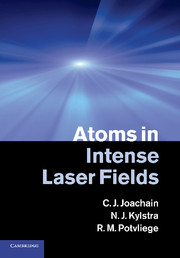2 - Theory of laser–atom interactions
Published online by Cambridge University Press: 05 January 2012
Summary
In this chapter, we shall discuss the theory of laser–atom interactions, using a semi-classical method in which the laser field is treated classically, while the atom is studied by using quantum mechanics. This semi-classical approach constitutes an excellent approximation for intense laser fields, since in that case the number of photons per laser mode is very large [1, 2]. In addition, spontaneous emission can be neglected. We begin therefore by giving in Section 2.1 a classical description of the laser field in terms of electric- and magnetic-field vectors satisfying Maxwell's equations. We start by considering plane wave solutions of these equations. Then general solutions describing laser pulses are introduced. The dynamics of a classical electron in the laser field, and in particular the ponderomotive energy and force, are discussed in Section 2.2. Neglecting first relativistic effects, we write down in Section 2.3 the time-dependent Schrödinger equation (TDSE), which is the starting point of the theoretical study of atoms in intense laser fields, and introduce the dipole approximation. In the subsequent two sections, we study the behavior of the TDSE under gauge transformations and the Kramers frame transformation. In view of the central role that the time evolution operator plays in the development of the theory of laser–atom interactions, some general properties of this operator are reviewed in Section 2.6.
- Type
- Chapter
- Information
- Atoms in Intense Laser Fields , pp. 37 - 90Publisher: Cambridge University PressPrint publication year: 2011



